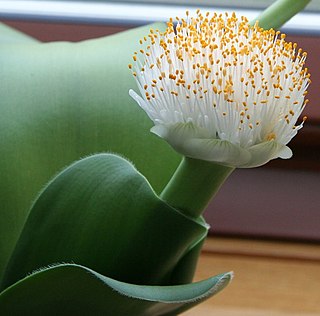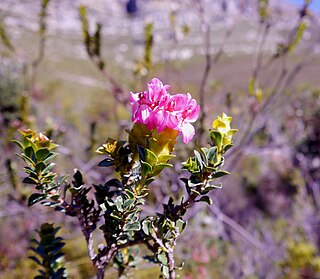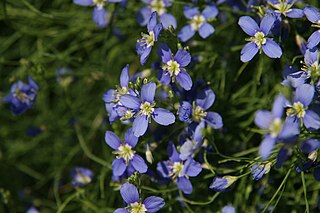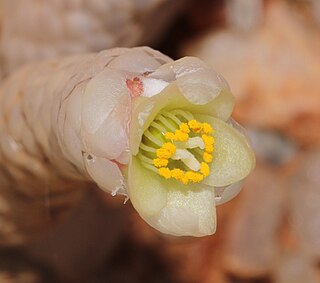
Kirstenbosch is an important botanical garden nestled at the eastern foot of Table Mountain in Cape Town. The garden is one of 10 National Botanical Gardens covering five of South Africa's six different biomes and administered by the South African National Biodiversity Institute (SANBI). Prior to 1 September 2004, the institute was known as the National Botanical Institute.

Haemanthus is a Southern African genus of flowering plants in the family Amaryllidaceae, subfamily Amaryllidoideae. Members of the genus are known as blood lily and paintbrush lily. There are some 22 known species, native to South Africa, Botswana, Namibia, Lesotho and Eswatini. About 15 species occur in the winter rainfall region of Namaqualand and the Western Cape, the remainder being found in the summer rainfall region, with one species Haemanthus albiflos occurring in both regions.

Haemanthus coccineus, the blood flower, blood lily or paintbrush lily, is a species of flowering plant in the amaryllis family Amaryllidaceae, native to Southern Africa. Growing to 35 cm (14 in) tall and wide, it is a bulbous perennial with short brown stems surmounted by red flowers, the flowers appearing in spring and summer, before the strap-shaped leaves.

Scadoxus puniceus, commonly known as the paintbrush lily, is a species of bulbous plant. It is native to much of southern and eastern Africa: Ethiopia, Sudan, Tanzania, Malawi, Mozambique, Zambia, Zimbabwe, Botswana, Eswatini (Swaziland), and South Africa. Scadoxus puniceus can be found in cool, shady habitat such as ravines and forests, where it is often found in moist leaf litter. Other common names include snake lily, royal paintbrush, King-of-Candida, African blood lily (English), rooikwas (Afrikaans), isisphompho, and umgola (Zulu). There are nine species of Scadoxus of which three, S. puniceus, S. multiflorus and S.membranaceus, occur in South Africa.

Kumara haemanthifolia is a species of flowering plant in the family Asphodelaceae. It is a rare species of succulent plant, native to a few high, inaccessible mountain peaks in the Fynbos habitat of Western Cape, South Africa.

Scadoxus multiflorus is a species of bulbous plant native to most of sub-Saharan Africa from Senegal to Somalia to South Africa. It is also native to Arabian Peninsula and to the Seychelles. It is naturalized in Mexico and in the Chagos Archipelago.It is also found in Indian peninsula. It is grown as an ornamental plant for its brilliantly coloured flowers, either in containers or in the ground in where the climate is suitable. There are three recognized subspecies. Strongly toxic like other Scadoxus species, it has been used as a component of arrow poisons and fishing poisons, as well as in traditional medicine. Common names, some of which are used for other species, include blood lily, ball lily, fireball lily, blood flower, Katherine-wheel, oxtongue lily, poison root and powderpuff lily.

Scadoxus membranaceus is a flowering plant in the Amaryllidaceae family. It is a bulbous plant from South Africa. The smallest of the species of Scadoxus, it is sometimes cultivated as an ornamental plant where a minimum temperature of 5 °C (41 °F) can be maintained.

Dierdré "Dee" Anne Snijman is a South African botanist and plant taxonomist who is notable for studying and writing extensively on bulbs. She has described over 120 species and has written comprehensive works on South African flora. She received the 1997 Herbert Medal from the International Bulb Society for her research on Amaryllis.

Penaea sarcocolla is a species of shrub in the genus Penaea. It is endemic to the Western Cape, along the coast up to Cape Agulhas and extending inland to Franschhoek, Hottentots Holland Mountains, Villiersdorp and Genadendal. It is also known as the Cape fellwort.

Heliophila coronopifolia is a species of flowering plant in the genus Heliophila. It is native to the Northern Cape and Western Cape provinces of South Africa.

Anacampseros papyracea is a species of succulent plant in the family Anacampserotaceae. It is endemic to Southern Africa.
The Kwelera Nature Reserve is a coastal dune forest reserve in the Wild Coast region of the Eastern Cape, South Africa. Access to the reserve is through the adjacent Kwelera National Botanical Garden, where the reserve now serves as the natural portion of the garden. The reserve stretches from the Kwelera River on the eastern side, to the Gqunube River (Gonubie) at the western end of the reserve. It is a park in the greater East London Coast Nature Reserve.

Haemanthus deformis is a perennial flowering plant and geophyte belonging to the genus Haemanthus. The species is endemic to the Eastern Cape and KwaZulu-Natal and occur from Umtata to Durban. The plant only grows in the forests near the coast and is threatened by the traditional medicine industry.
Haemanthus graniticus is a perennial flowering plant and geophyte that belongs to the genus Haemanthus and is part of the Renosterveld. The species are endemic to the Northern Cape. There are three subpopulations in an area of occurrence of 2,500 km2 (970 sq mi), it occurs from Springbok to the Kamiesberge. The plant is threatened by its habitat being plowed up for agricultural purposes and the illegal collection of the plants by horticulturalists.

Haemanthus humilis is a perennial flowering plant and geophyte belonging to the genus Haemanthus. The species is native to South Africa, it occurs in every province, as well as Botswana and Lesotho.

Haemanthus lanceifolius is a perennial flowering plant and geophyte belonging to the genus Haemanthus.

Haemanthus montanus is a perennial flowering plant and geophyte belonging to the genus Haemanthus. The species are native to Gauteng, KwaZulu-Natal, Mpumalanga, North West, Eastern Cape and the Free State as well as Botswana.
Haemanthus namaquensis is a perennial flowering plant and geophyte that belongs to the genus Haemanthus and is part of the Succulent Karoo vegetation. The species is native to the Northern Cape and Namibia. It occurs from southern Namibia to Karkams in Namaqualand. There are eight subpopulations in an area of occurrence of 4000 km2, the plant is considered rare.

Haemanthus nortieri is a perennial flowering plant and geophyte belonging to the genus Haemanthus. The species are endemic to the Western Cape and occur on the Nardouwberg. The plant has an area of occurrence smaller than 100 km² and there are three subpopulations. It is threatened by overgrazing and trampling by livestock, road construction, invasive plants and illegal collection by horticulturists.

Haemanthus pumilio is a perennial flowering plant and geophyte that belongs to the genus Haemanthus and is part of the fynbos and Renosterveld. The species are endemic to the Western Cape and occur at Stellenbosch. The plant has lost 60% of its habitat in the last 90 years with at least 20% occurring in the last 60 years due to crop cultivation and development. There are currently two subpopulations left consisting of approximately 2000 plants. These plants are threatened by illegal collection by horticulturists, uncontrolled fires and destruction by locusts and rodents.
















